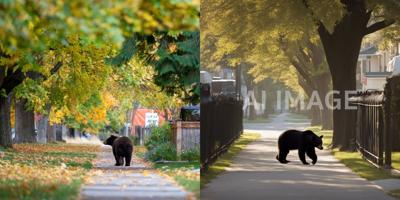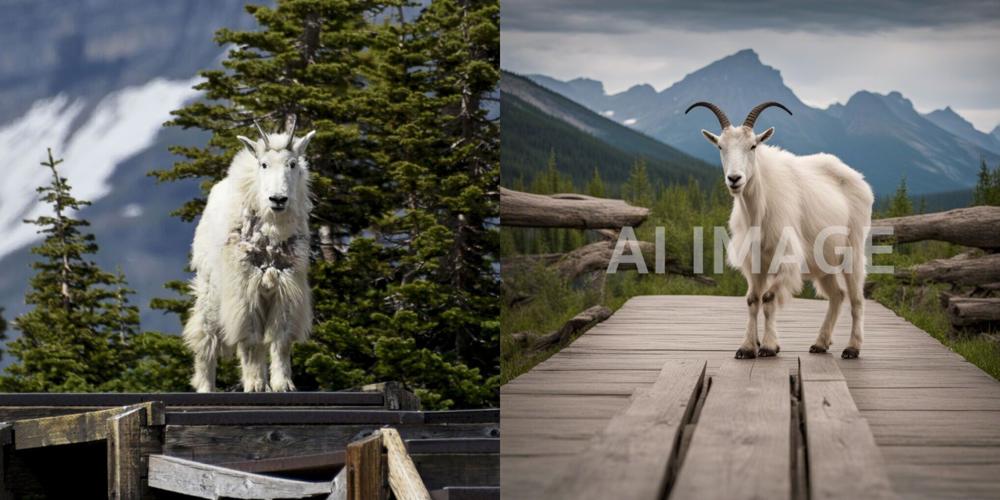AI has come for the animals.Â
When the Montana Department of Fish, Wildlife & Parks unveiled its  on Jan. 1, the magazine carried an explanation on page 1: Magazine staff, editor Tom Dickson wrote, had gone to great lengths to verify that photos submitted for the issue were, in fact, photos.Â
Dickson's concern was that images produced by generative artificial intelligence — AI programs that create new material in response to a prompt — now often appear as realistic as actual photographs and could be submitted to the magazine for publication.
"To ensure that no AI-generated photos sneak into Montana Outdoors, we closely examine the original image files (and the data embedded in them) in search of any hint of fakery or manipulation," he wrote. "We also rely on our submitting photographers to adhere to the highest level of ethical standards, which also includes not sending photos taken outside of Montana or any of captive animals."Â
People are also reading…
Dickson suggested that using AI to create fake wildlife or landscape photos would be antithetical to the premise, and challenge, of producing authentic photos: "Instead of an intrepid photographer trekking into the Purcells to capture a stunning photo of a Canada lynx in its natural surroundings, someone in their pajamas can bang one out on a smartphone while waiting for their coffee to brew."Â
But he also had another concern that extended beyond maintaining the integrity of this year's 50-page spread of wildlife and landscape photos from around the state. What if, he wondered, AI-generated images were used to subvert wildlife conservation and management, or even the basic scientific foundation underlying those things?Â
"Imagine someone using the technology to create a photo of several black-footed ferrets — the rarest mammal in North America — frolicking in a park in downtown Missoula," he pondered. "Maybe these little carnivores aren’t so endangered after all?"
Blurred lines
Luke Duran, the magazine's art director for the past 22 years, said in an interview Thursday that he wasn't aware of anyone yet submitting an AI-generated image to the publication. But if someone did, "We never would willingly or knowingly feature one."
He's contended for years with submitted photos that were altered using software like Adobe Photoshop. He's aware of only a few that errantly made it into publication. One was a "beautiful underwater photo of some cutthroat trout" in which readers noticed the same set of pebbles repeated multiple times on the stream bed.Â
Aside from fakery or image manipulation, Duran said, he also declines to publish images that have been over-processed, such as those with altered colors or excessive darkening or lightening.Â
But, he noted, he does publish photos taken by remote camera setups. While a photographer must position the camera to intentionally compose a photo, the camera is automatically triggered when an animal walks by — the photographer doesn't snap the photos themselves.Â
"We are kind of graying the lines of what we are accepting" by taking remote camera shots, he said, noting that sometimes that's the only way to capture animals like wolverines or mountain lions close up.Â
Faked photos
Duran said his experience vetting wildlife photos helps him detect when an image might be faked altogether. He asks photographers to specify exactly what species is in a photo along with roughly when or where they took the photo. When he isn't sure about a photo, he calls the photographer to get more details.Â
The magazine's staff has "increased awareness, hyper awareness, that we’re not letting faked photos come through," he said. But, "It’s going to get harder and harder to identify the fakes, I think," as AI technology produces more realistic images each year.

An AI-generated image shows a grizzly bear riding a motorcycle.
The Missoulian created multiple AI-generated images for this story. The images, created with the generative AI program Stable Diffusion, were each based on one-sentence written descriptions of actual wildlife photos taken by Missoulian photographers. Two more were based on a prompt of black-footed ferrets in Missoula. In the past, creating a realistic fake photo took a mastery of Photoshop or similar, expensive software. Now it takes a few keystrokes and a 10-second processing time on a web app that costs less than a craft cocktail.Â

An AI-generated image shows a grizzly bear riding a rocket.
Some of the images appear mostly realistic, others not so much. A bear cub on a road has eight claws on each front paw. A log right behind a mountain goat inexplicably fades into timber on a distant mountainside. A bighorn sheep doesn't look quite real, but a black bear on a sidewalk and one in a tree are a bit more believable. Animal-free images based on prompts of Glacier National Park were more realistic.Â
The images could also veer into the absurd, a product of AI "hallucinations" or the programs' simple failure to generate accurate images that match reality. AI is notorious for its inability to replicate human hands and objects like bicycles. And AI-generated images can be intentionally absurd: a grizzly riding a motorcycle or a rocket.Â
"I don’t think that the technology is quite there that we couldn’t spot an AI-generated photo," Duran said. "But I think in one year’s time, that’s not true."Â
Duran shared his editor's concern that spoofed images could be used to give "false pretense" to wildlife abundance.Â
Conservation concern
Dickson and Duran aren't alone in their concern about AI images' implication for conservation.
Allen Murabayashi, co-founder of the image platform PhotoShelter and a former judge of the Audubon Photography Awards, that generative AI poses a threat to conservation by undermining photography's long-standing role in illustrating and verifying conservation concerns. Whether in the sphere of conservation or elsewhere, the argument goes, AI images erode trust in photography, thus making people distrustful of all images, even legitimate ones.
"AI makes it easier to sow doubt and spread disinformation designed to alter our beliefs and behavior," he wrote. "Ironically, these dynamics may also make it harder to trust remarkable yet real photos."Â
Murabayashi cited a spring 2023 incident in which international human rights group against protesters in Colombia two years prior.Â
The dramatic images, posted online, were compelling and looked real at first glance. ; Amnesty's images were not. Journalists, photographers and scholars on misinformation pilloried Amnesty for undermining the credibility of actual protest photographs with its fakes. Amnesty later removed the images.Â
Convincing fakes
Other AI images passed off as photographs have been more successful in their deception.
German artist Boris Eldagsen won the 2023Â Sony World Photography Awards' creative photo category with a black-and-white image of two women. to see if the contest was prepared to weed out faked photos. Upon winning, he came clean about the ruse and refused the prize.
Also in 2023, content agency with an AI-generated image that looked like an aerial drone shot of surfers at sunrise. Like Eldagsen, the company refused the prize and explained that it entered the image to prove that AI images had become so realistic that they could be entered into, and even win, a photography competition. Â
In 2022, Romanian photographer Aurel Manea gained attention for his collection of AI-generated landscape photos. The images were all  based on Manea's text prompts.
Manea's AI images could fill a professional landscape photographer's photo book or gallery, replete with breathtaking scenes in mostly mountainous landscapes — none of which actually exist. In one, sunlit granite peaks glow orange in the evening sun, flanked by glacial valleys rimmed with snow and looming over a tranquil lake. It looks like a scene from Glacier National Park. Â
"I can’t, as a landscape photographer myself, emphasize enough what these new technologies will mean for photography," he told the photography website PetaPixel.Â
In yet other realms, and the latter's subsequent bombing and invasion of Gaza. AI usage by newspaper company Gannett led to a , Ohio; Donald Trump's former longtime fixer Michael Cohen ; and Sports Illustrated was under the bylines of nonexistent, AI-generated "writers."Â
Data benefits
Alongside their warnings on AI, Murabayashi and others also point out that AI technology is, in some ways, already helping conservation efforts — particularly with data analysis.Â
"Automated machine-learning programs now comb through camera-trap, drone, and satellite images, as well as audio recordings, to monitor birds around the world, especially in remote areas that few people visit," Murabayashi wrote. "Predictive models based on such data are helping to proactively combat threats such as poaching."
In 2018, the journalist Julia John, then a science writer at The Wildlife Society, from remote, motion-activated wildlife cameras. At the time, a group of wildlife researchers and computer scientists had on using AI to gather wildlife image data.
"We have AI automatically take care of the easy photos to let people spend time labeling the challenging photos," Jeff Clune, a University of Wyoming computer science professor who co-authored the study, told John. "The hope is to have a cycle in which humans label some data, AI tries to automate that task and humans help the AI by labeling what it cannot do until it can do the entire job."Â
























